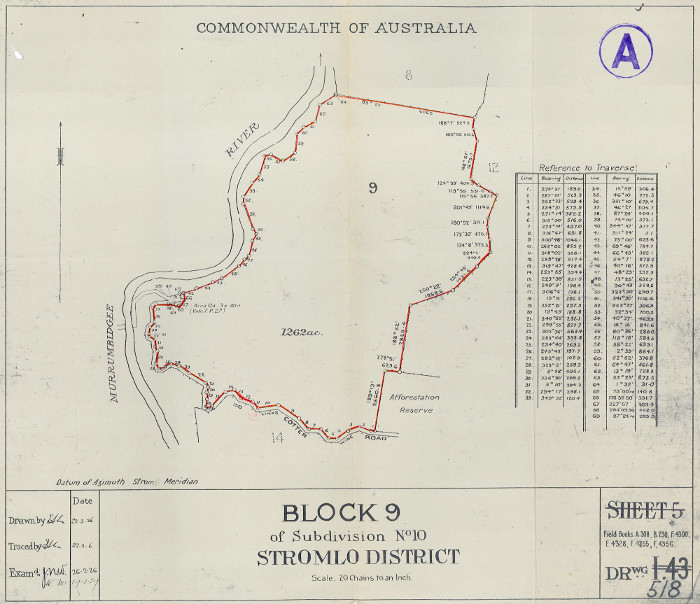Eric George McMurtrie
Blocks 9 & 36 Stromlo District
Eric George McMurtrie was born in Sydney in 1888. He had worked for 17 years in farming before enlisting on the 11th August 1915. He initially served with the Australian Army Service Corps in France until being commissioned as a Lieutenant and joining the Australian Flying Corps in 1917. He returned to Australia in October 1918 and was discharged in January 1920.
Stromlo Block 36 - Property Names: 'Village Paddock' or 'Gulla Gulla'
In his 1920 application for for a Soldier Settlement block, McMurtrie described himself as 32 years old, 6 feet ½ inches (184 cm) tall, married to Ruth with one child, Noelle. In March 1921, McMurtrie received confirmation that he had a 25 year lease on the 1130 acre (457 hectare) Stromlo Block 36. The lease was back dated to start from the 5th April 1920 at an annual rental of £270/14/6.
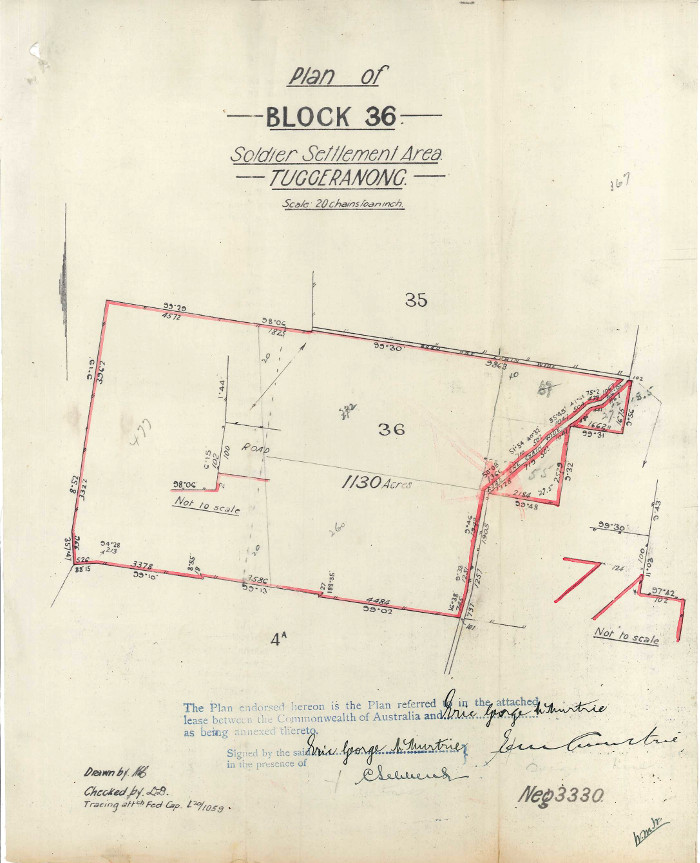
Plan of Stromlo Block 36.
McMurtrie renamed the property Gulla Gulla in 1921, the name reputedly coming from his daughter Noelle. As a baby, she would crawl around saying "gulla, gulla."
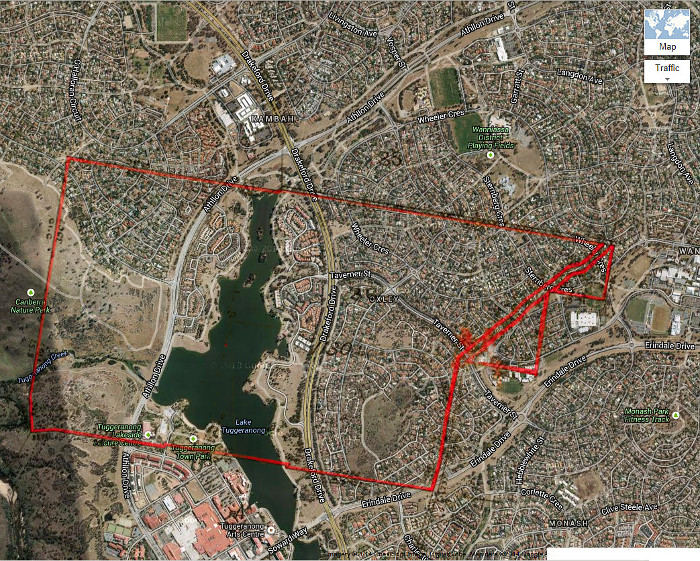
Google Maps image of area c2013 with Stromlo Block 36 boundary in red.
At first McMurtrie and his family lived in a Hudson & Sons portable cottage. It was located near the north western corner of the block (near the old Urambi Primary School) and had been erected by a previous lessee. The house was moved in 1921 at a cost of £300 and insured for £600, one of the conditions for a Commonwealth advance McMurtrie received. The site of the house is now parkland off Watkins Street in Wanniassa near St. Mary McKillop College. The outline of several buildings can be seen in the park as well as some original pine trees.
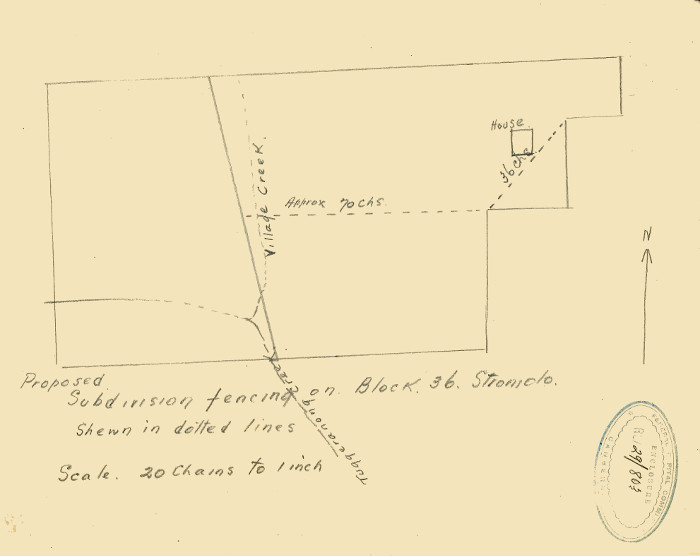
Sketch of Stromlo Block 36 showing location of farmhouse in 1929.
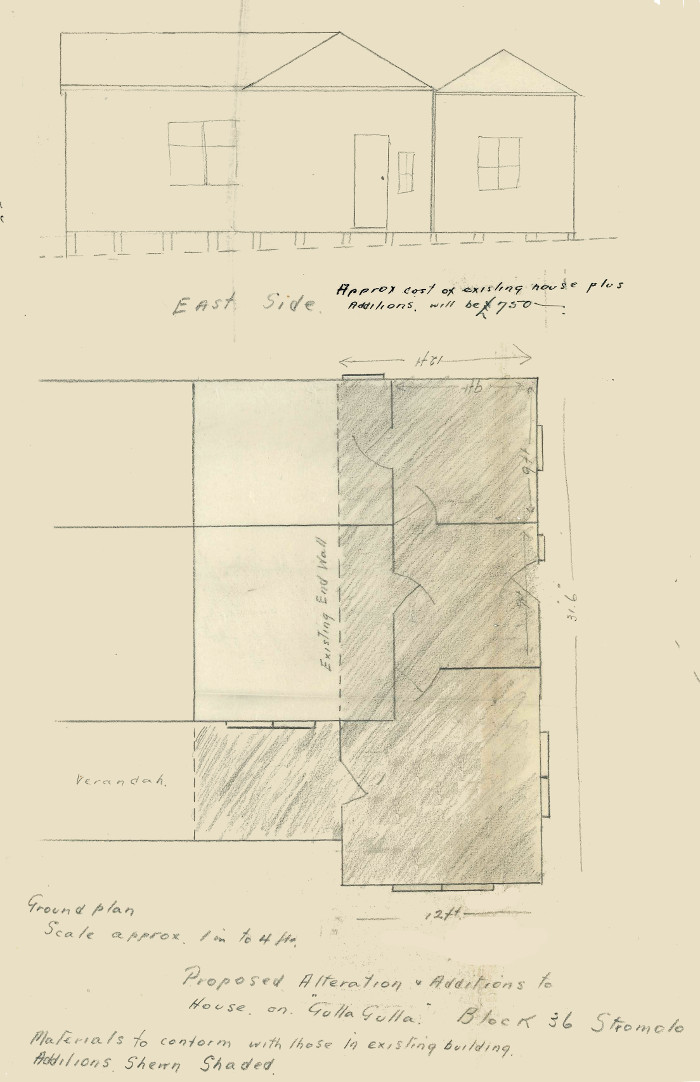
Sketch of proposed extensions to farmhouse in 1929.
McMurtrie was not beyond creating controversy while leasing his block. In 1922, Lands Inspector, James Brackenreg, reported that McMurtrie had 1500 sheep on Stromlo Block 36. Apparently these were not owned by him as he had depastured his sheep to his neighbour Alexander Powell's block. As the sheep were mortgaged to the Commonwealth, Brackenreg questioned whether McMurtrie had permission to do this. He believed that McMurtrie was "a dealer and should be handled carefully." It would not be the last run in between Brackenreg and McMurtrie.
By May 1922, McMurtrie had suffered such losses with his own sheep that he needed outside work to stay afloat. He received consent from the Commonwealth Surveyor General, Colonel John Goodwin, to sublet Stromlo Block 36 to W.G. Hyles of Bungendore. McMurtrie and his family moved to Winslade station near Cloncurry in Queensland to manage it on his father-in-law's behalf.
By March 1924, McMurtrie owed the Commonwealth £303/4/3 in rent, penalties for late payment and for clearing rabbits and briars. Brackenreg then recommended that McMurtrie be called before the Land Board to show cause as to why his lease should not be determined. McMurtrie responded it would cost him £60 to travel between Canberra and Winslade, so instead he submitted a statement in support of his case. Before the Board met, Brackenreg inspected the property again and reported there were over one hundred rabbits killed and a large amount of briar destroyed. This was the third time the Commonwealth had had to clear Stromlo Block 36 and McMurtrie had yet to pay for any of the work.
In his statement to the Land Board, McMurtrie argued that when he stocked his lease in November 1919:
"I had the misfortune to hit upon the highest prices obtaining for years and in a few months they were down to the lowest level, and wool prices were just the same."
McMurtrie proposed paying off his debt in three equal instalments ending in December 1924. The Board accepted the arrangement.
Even though he paid off what he owed in 1924, McMurtrie again fell behind in his rent payments and repayments on an advance for his house. Brackenreg suggested that he be threatened with legal action. "No lessee in the Federal Territory has ever been treated more leniently", he wrote "and there is no justification for leniency in this particular case." In 1925, McMurtrie's brother (who was living on Gulla Gulla) suggested an arrangement whereby they pay the Commonwealth to regularly clear the property of the pest. In March 1926, Brackenreg recommended termination of the lease because "from the very inception Mr. McMurtrie has been a very unsatisfactory lessee" and was still behind in his rent.
However, no action was taken. Nor in December 1928 when McMurtrie was again asked to appear before the Land Board. An exasperated Brackenreg thought that it was unfair to other lessees that McMurtrie should be allowed to carry on. As the Depression progressed so did McMurtrie's indebtedness and by October 1934 he owed £714/2/11. He sought approval to transfer the lease to Ronald Merriman from Yass, NSW and did so on the 1st November 1934 for £5500.
Merriman already held the lease to Stromlo Block 20 and sold both to Richard Hyles from Bungendore in February 1937. Hyles in turn transferred it to his father almost immediately. By August 1939, Gulla Gulla was occupied by Geoff Hyles and he held the property until it was resumed for suburban development in the early 1970s.
Despite the difficulties he had experienced with Block 36, within weeks of selling Gulla Gulla McMurtrie purchased another property, Block 9 in the District of Stromlo.
Stromlo Block 9: Property Name: 'Winslade'
Block 9 in the District of Stromlo was originally part of Yarralumla and was 1263 acres (511 hectares) in size with the Murrumbidgee River on its western boundary, the Cotter Road to the south and Mount Stromlo to the east. It was first leased in 1926 to Henry Thomas Brown of Bulga Creek for a ten year period. Brown's father had been a long term employee of Frederick Campbell on Yarralumla and Harry Brown worked for Campbell as well, but did not serve in World War 1.
Plan of Stromlo Block 9. Click on plan for larger view.
In 1927, Brown built a five room cottage close to the Cotter Road which he called Arawang. He ran sheep on the property, shearing around 800 a year. By the early 1930s, at the height of the Depression, his income from wool was barely sufficient to cover his annual rent on the block. Brown signed a new 25 year lease beginning on the 1st July 1933 but in January 1935 applied to transfer the lease to Eric McMurtrie.
McMurtrie paid Brown £1940 for his livestock and property improvements including the cottage, garage shed and skillion, two sheepyards, fencing, water pipes and a water tank. By 1936 he was referring to his new property as Winslade, the same name of his wife's family property in Cloncurry.
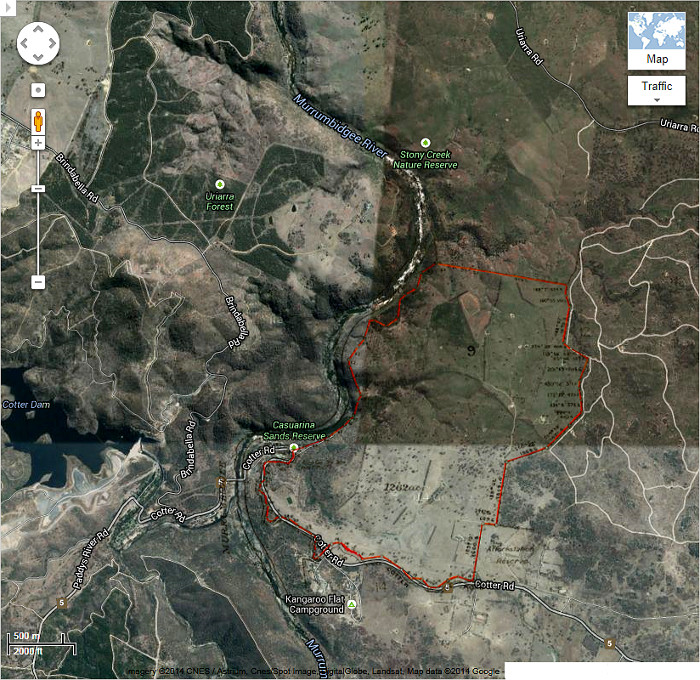
Google Maps image of area c2013 with Stromlo Block 9 boundary in red.
One of the difficulties of Stromlo Block 9 was that the water pipeline from the Cotter Pumping Station to Mount Stromlo traversed the property. This was a regular source of irritation for McMurtrie as workers dug holes for maintenance pits. This not only caused disruption to his use of the land but also caused loss of sheep when they fell into the holes. At the time, he was also struggling to pay his rates. After being issued with a summons in 1939, he wrote to Surveyor General Arthur Percival stating that he was financially embarrassed due to commitments and unsatisfactory market conditions. The summons was withdrawn. In May 1940, McMurtrie was advised that a new above-ground pipeline would be built through Winslade.
With the outbreak of WW2, McMurtrie re-enlisted in the RAAF reaching the rank of Wing Commander, though his postings were clerical within Australia. In December 1941, he complained to the Commonwealth Surveyor General Arthur Percival about what he believed was an increase in rent. He argued the Commonwealth could not do this under the provisions of the National Security (War Service Moratorium) Regulations, which came into force on the 21st March 1941. Percival replied that his rent was not being increased but that an allowance for improvements of five pence per acre per annum, which McMurtrie had been receiving until then, was being ceased.
By 1942, McMurtrie was still in debt to the Commonwealth causing Percival to note that "McMurtrie has long been a defaulter with the payment of rent etc" and he thought that the matter should be referred to the Crown Solicitor. When the property came up for reappraisement of the rent in 1946, McMurtrie argued that much of the land fell away to the Murrumbidgee River and could not carry more than five sheep per acre. He thought that no more than eight acres (3 hectares) was suitable for cultivation.
In his absence during WW2, the Department of Interior had allowed a woodcutter on licence to fell thousands of trees, thus disturbing McMutrie's quiet enjoyment of the block. By 1951, his annual rent was £402/19/4 and he received an allowance for the pipeline of £7/18/4 per annum.
During the 1950s his son, Eric Jr., became the manager of Winslade and Eric McMurtrie Snr. moved to Sydney where he died on the 7th February 1975.
Sources
- ArchivesACT: Government Property & Tenancy Registers - Stromlo Block 9 (
 PDF 1.33Mb)
PDF 1.33Mb) - ArchivesACT: Government Property & Tenancy Registers - Stromlo Block 36 (
 PDF 807Kb)
PDF 807Kb) - ArchivesACT: Rate Book : Territory for the Seat of Government - 1928 (
 PDF 18.7Mb) - 1929 (
PDF 18.7Mb) - 1929 ( PDF 8.88Mb)
PDF 8.88Mb) - ArchivesACT: TL904 (Part 1) - Stromlo Block 9
- ArchivesACT: TL904 (Part 2) - Stromlo Block 9 - E.G. McMutrie
- ArchivesACT: TL904 (Part 3) - Stromlo Block 9 - E.G. McMutrie
- ArchivesACT: TL6180 (Part 1) - Block 36 Stromlo - G.G. Hyles
- ArchivesACT: TL6180 (Part 2) - Block 36 Stromlo - G.G. Hyles
- NAA: (CP326/8) - CS31 EG McMurtrie Block 26 Stromlo
- NAA: (A361) - DSG1922/1889 Block 26 Stromlo EG McMurtrie
- NAA: (A6273) - L1925/27 Block 26 Stromlo EG McMurtrie building advance
- NAA: (B2455) First Australian Imperial Force Personnel Dossiers, 1914-1920: http://discoveringanzacs.naa.gov.au/browse/person/44856
- Canberra & District Historical Society Excursion Notes - October 1994
- Family Notices. The Argus (Melbourne), 19th June 1925, p.1: http://nla.gov.au/nla.news-article2128057
- ACT Memorial - McMurtrie, Eric George: http://www.memorial.act.gov.au/person.php?id=4065

